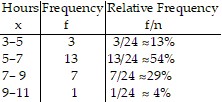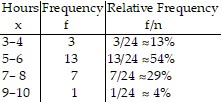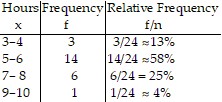Complete the magic (addition) square.Use each number 22, 23, 24, 25, 26, 27, 28, 29, and 30 once.
A. 
B. 
C. 
D. 
Answer: D
You might also like to view...
Use the given data to construct a frequency and relative frequency distribution.Kevin asked some of his friends how many hours they had worked during the previous week at their after-school jobs. The results are shown below.6?5?6?3?6?6?9?8?6?4?8?55?8?6?5?8?6?5?8?5?8?8?3Construct a frequency and relative frequency distribution. Use 4 classes.
A. 
B.

C.

D.

Provide an appropriate response.Write a problem in which the quadratic equation  must be solved in order to solve the problem.
must be solved in order to solve the problem.
What will be an ideal response?
Solve the problem.Find the equation of the line through (0, -8) and perpendicular to the line y = -4x + 4.
A. y = -  x - 8
x - 8
B. y =  x - 8
x - 8
C. y =  x + 8
x + 8
D. y = -4x - 8
Solve the problem.The linear function f(x) = 3.1x + 33 models the percentage of people, f(x), who graduated from college x years after 1998. Find and interpret the slope.
A. m = 3.1; the percentage of people graduating from college has decreased at a rate of 3.1% per year since 1998. B. m = 33; the percentage of people graduating from college has increased at a rate of 33% per year since 1998. C. m = -3.1; the percentage of people graduating from college has decreased at a rate of 3.1% per year since 1998. D. m = 3.1; the percentage of people graduating from college has increased at a rate of 3.1% per year since 1998.